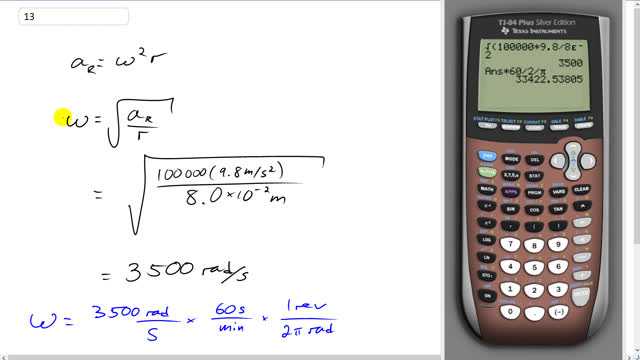
How fast (in rpm) must a centrifuge rotate if a particle 8.0 cm from the axis of rotation is to experience an acceleration of 100,000 g’s?

In order to watch this solution you need to have a subscription.
This is Giancoli Answers with Mr. Dychko. The acceleration they are speaking of in this question is radial acceleration; there's no tangental acceleration because it asks how fast must the centrifuge rotate which kinda presumes that it's rotating at a constant angular speed in which case there's no tangental acceleration. And so we have radial acceleration is angular velocity squared times the radius. So we'll solve this for ω by dividing both sides by r and then take the square root of both sides and switching the sides around as well so we have the unknown ω on the left and ω is square root acceleration over radius. So that's square root of 100,000 g's which means 100,000 times 9.8 meters per second squared per g and then divide that by the radius expressed in meters so centimeters means times 10 to the minus 2 so we have 8.0 times 10 to the minus 2 meters and that works out to 3500 radians per second. It tells us to express our answer in 'rpm' so we'll take this radians per second times by 60 seconds for every minute and then 1 revolution for every 2π radians and you end up with 33000 revolutions per minute.
A student wrote: "I was looking at your solution for problem 8 in chapter 13. I am confused as
to how you derived the equation that you used. I could find no reference of
it in the book or other resources. Thank you for your help."
comes from equation 8-6 on page 202. It's a different way of writing centripetal acceleration. The other way of writing it is , but with a substitution for as , you end up with .
Hope that helps,
Mr. Dychko